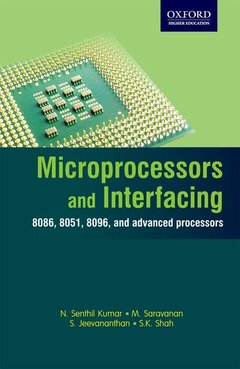Microprocessors and interfacing
Langue : Anglais
Auteurs : Kumar N Senthil, Saravanan M, Jeevananthan S, Shah Satish

Microprocessors and Interfacing is a textbook for undergraduate engineering students who study a course on various microprocessors, its interfacing, programming and applications. The book in eighteen chapters provides a very brief overview of 8085 processors, followed by a detailed discussion of 8086 architecture, programming and interfacing concepts. The book also provides a brief treatment of 8088 processors bringing out its architectural difference in relation to 8086. The thrust of this book is on 8086 processors. Subsequently, the book discusses the 8-bit 8051 and 16-bit 8096 microcontrollers. The last chapter on advanced processors briefs on 80186, 80286, 80386, 80486, Pentium, PowerPC, PIC, RISC& CISC, SUN SPARC and ARM microcontrollers. Providing a balance between theory and practice, the book is interspersed with complete ALP codes, review questions, programming and design based exercises.
Preface. 1. Microprocessors-Evolution and Introduction. 1.1 Introduction. 1.2 Explanation of Basic Terms. 1.3 Microprocessors and Microcontrollers. 1.4 Microprocessor-based System. 1.5 Origin of Microprocessors. 1.5.1 First generation (1971-1973). 1.5.2 Second generation (1974-1978). 1.5.3 Third generation (1978-1980). 1.5.4 Fourth generation (1981-1995). 1.5.5 Fifth generation (1995-till date). 1.5.6 Timeline of microprocessor evolution. 1.6 Classification of Microprocessors. 1.7 Types of Memory. 1.8 Input and Output Devices. 1.9 Technology Improvements Adapted to Microprocessors and Computers. 1.10 Architecture and signals of 8085. 1.11 Instruction set of 8085. 1.12 Memory and I/O interfacing with 8085. 1.13 Interrupt structure of 8085. 2. Methods of data transfer and serial transfer protocols. 2.1 Data Transfer Mechanisms. 2.2 Memory-mapped and I/O-mapped Data Transfer. 2.3 Programmed Data Transfer. 2.4 Direct Memory Access. 2.5 Parallel Data Transfer. 2.5.1 PCI bus. 2.6 Serial Data transfer. 2.6.1 Introduction to RS-232 standard. 2.6.2 Introduction to RS-485 standard. 2.6.3 GPIB/IEEE 488 standards. 2.6.4 USB. PART 1: INTEL 8086-16-BIT MICROPROCESSORS. 3. Intel 8086 Microprocessor architecture, features, and signals. 3.1 Introduction. 3.2 Architecture of 8086. 3.2.1 Execution unit. 3.2.2 Bus interface unit. 3.2.3 Differences between 8086 and 8088. 3.3 Accessing Memory Locations. 3.4 Pin Details of 8086. 3.4.1 Function of pins common to minimum and maximum modes. 3.4.2 Function of pins used in minimum mode. 3.4.3 Function of pins used in maximum mode. 4. Addressing modes, instruction set, and Programming of 8086. 4.1 Addressing Modes in 8086. 4.1.1 Register addressing mode. 4.1.2 Immediate addressing mode. 4.1.3 Data memory addressing modes. 4.1.4 Program memory addressing modes. 4.1.5 Stack memory addressing mode. 4.2 Segment Override Prefix. 4.3 Instruction Set of 8086. 4.3.1 Data transfer instructions. 4.3.2 Arithmetic instructions. 4.3.3 Logical instructions. 4.3.4 Flag manipulation instructions. 4.3.5 Control transfer instructions. 4.3.6 Shift/rotate instructions. 4.3.7 String instructions. 4.3.8 Machine or processor control instructions. 4.4 8086 Assembly Language Programming. 4.4.1 Writing 8086 programs using line assembler. 4.4.2 8086 Assembler directives. 4.4.3 Writing assembly language programs using MASM. 4.5 Program Development Process. 4.6 Modular Programming. 4.6.1 CALL Instruction:. 4.6.2 RET instruction. 4.6.3 MACRO. 4.6.3.1 Illustrative Example. 5. 8086 interrupts. 5.1 Introduction. 5.2 Interrupt Types in 8086. 5.3 Processing of Interrupts by 8086. 5.4 Dedicated Interrupt Types in 8086. 5.4.1 Type 00H or divide-by-zero interrupts. 5.4.2 Type 01H, single step, or trap interrupt. 5.4.3 type 02H or NMI interrupt. 5.4.4 Type 03H or one-byte INT interrupt. 5.4.5 type 04H or overflow interrupt. 5.5 Software Interrupts-Types 00h-FFH. 5.6 INTR Interrupts-Types 00h-FFH. 5.7 Priority among 8086 Interrupts. 5.8 Interrupt Service Routines. 5.9 Bios Interrupts or Function Calls. 5.9.1 INT 10H. 5.9.2 INT 11H
Dr N Senthil Kumar is Professor, Department of Electrical& Electronics Engineering, Mepco Schlenk Engineering College, Sivakasi, Tamilnadu. He has more than 20 years of active teaching and research experience. Dr M Saravanan is Professor, Department of Electrical& Electronics Engineering, Thiagarajar College of Engineering, Madurai, Tamilnadu. He has more than 15 years of teaching cum research experience. Dr S Jeevananthan is Asst. Professor, Department of Electrical& Electronics Engineering, Pondicherry Engineering College, Puducherry. He has around a decade of experience in teaching undergraduates and postgraduates. Dr Satish Shah is Professor, Department of Electrical Engineering, The Maharaja Sayajirao University of Baroda, Vadodara.
Date de parution : 07-2012
Ouvrage de 720 p.
16.2x24 cm
Disponible chez l'éditeur (délai d'approvisionnement : 14 jours).
Prix indicatif 28,45 €
Ajouter au panier
© 2024 LAVOISIER S.A.S.



